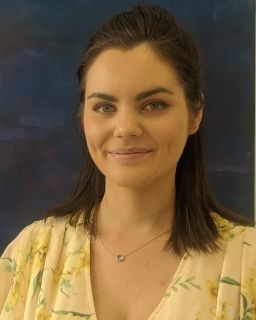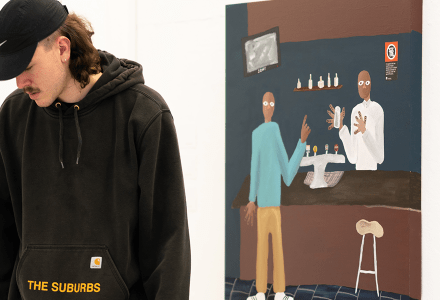Felicity Perrers
My family had faith in me, my friends had faith, and the university supported me. At no point did anyone doubt that I could do what I was setting out to do.
If Felicity Perrers could be described in one word, it would be this: driven.
“I had a plan,” she says firmly. “I wanted to Honours, and I wanted to do Honours next year. I was going to graduate at the end of this year so I wouldn't have to do a single course or a part-time semester at the start of next year.”
At the time when she thought this, she was in the process of completing a Bachelor of Art History and Curatorship, and a Bachelor of Visual Arts, majoring in Painting.
“I've always loved art. When I was growing up, I used to drag my siblings into drawing competitions so I could draw with someone else. So stupid,” she says with a laugh.
Her double degree has been the perfect pairing for her because it combines the practical – creating something – with the theory.
“With the art history side of things, it's learning about the context of what other people have created but also the context for what I'm creating as well,” she says.
Felicity's plans were almost derailed mid- this year when she received a life-changing diagnosis. It happened when she returned to Brisbane during the break.
“I didn't realise I was sick until I went home and my mum saw me. She was like, 'Oh my god – what's wrong with you?'”
Felicity would walk down the street and need to sleep for four hours afterwards. She recalls having become desperately underweight. She had no energy. Still, she hadn't thought anything was seriously wrong.
“When I finally got to the emergency room, they said I had maybe a few hours before I had a massive heart attack or stroke. I was at death's door,” Felicity says.
It was Type 1 diabetes, and she was in severe diabetic ketoacidosis. She explains it's when you can't access glucose for energy and your body instead breaks down fat and protein. It starts to turn your blood acidic, which can damage your organs.
After a few days in the ICU, Felicity was transferred to a ward, where she spent most of her break. In the ward, she was emailing the ANU School of Art and Design.
“I was saying, 'I'm so sorry I'm going to miss the first week of classes – how can I catch up?'” she says.
Her diabetes isn't something Felicity has spoken widely about. So she's a bit nervous talking about it now.
“I don't like to ask for help or admit that I need things,” she says. “I don't like people thinking there's something different about me so I don't tend to share a lot about the diabetes. It's still really new to me.”
She also cites a lack of understanding about how people develop Type 1 Diabetes.
“A lot of people think it's the result of being unhealthy and a poor lifestyle. But I've always been really healthy. It's an autoimmune condition.”
She adds: “There's a lot of confusion and misinformation about diabetes, so people might think it limits me in some way.”
Her doctors had recommended that she take this semester off and focus on her health. Felicity had a plan though. So she returned to Canberra.
“My family had faith in me, my friends had faith, and the university supported me,” she says. “At no point did anyone doubt that I could do what I was setting out to do.”
She singles out her parents, whom she calls her “rocks”. Her mother accompanied her to every doctor's appointment and would take notes. And when Felicity returned from the hospital, every time she walked past her father he'd have his laptop open to a medical journal article on Type 1 Diabetes.
“He spent a full week on the computer researching, educating himself,” Felicity says. “I couldn't have done this without my parents.”
In second semester, Felicity overloaded her courses, taking five subjects.
Head of Painting, Dr Peter Alwast, was very supportive, she says. “He wanted to make sure my health was my first priority. He was very understanding.”
“So I've had a lot of support not just from my family but from the university as well. The community here is pretty special at the art school. I've formed connections here that I don't think I could have anywhere else.”
Felicity is graduating this December with High Distinctions for all her courses.
“My life changed fairly significantly this year, and I'm proud of what I've achieved and overcome,” she says. “Graduation is a way of acknowledging that, so it means a lot to me.”
Next year she'll do Honours. Beyond that, she'd like to work in the arts, in a gallery or museum. Maybe. She's trying harder to be flexible these days.
“I've realised I can't control everything, even though I've always wanted to previously,” Felicity says. “I've learned I have to let go and see what the future holds, because there are things you can't plan for.”
But, she adds, “I'm excited to see what happens.”
Best moments of Felicity's time at ANU
“We have what's called Tuesday on my Wall in Painting,” she says. “We all put our work up in the display space and have wine and nibbly things. We'd talk about our work in a constructive but supportive way.”
As part of her final semester in her Art History and Curatorship degree, Felicity did a curatorial internship. She cites a bit accomplishment in that course as having helped organise a panel discussion about an exhibition the School staged called 'A Paper Inheritance'. She also moderated the discussion.
“I was quite nervous to do that,” she says. “The panel members were all people I really respected, artists form Canberra and pillars of the School of Art and Design community. People who have a deep connection to the printmaking workshop.”
“That was a huge success as a public program – so many people turned up. It all worked out in the end!”
About Felicity's final project paintings
Felicity's paintings seem to represent the two degrees she's earned working in concert with one another. They're physical creations which require you to understand the context and ideas that underlie them to be fully appreciated.
“I'm interested in what painting means today and what it means to look at a painting,” Felicity says. “I've been researching a lot about post-internet art and the influence of the screen and digital technology on the way we look at art.”
From that, she wanted to create paintings that were immersive material objects. Some of her creations were recognisably houses (titled 'Home address') while others looked more abstract. All were painted from really pixelated, corrupted screenshots taken from Google Streetview of two of her childhood homes.
“It was about getting a digital place or address and making something physical,” Felicity says. “Making the public image on Google Streetview into something that was mine, in a way – but still referencing the pixelated structure in the way I painted them.”
She describes looking at the Streetview pictures as being like spying on the past: “It's an external view of a place you know so intimately.”
“The internet can be a distancing tool as well as a tool of access. I can see my childhood homes in Queensland from a computer in Canberra and paint those but not actually visit them.”
Her decision to paint her past childhood homes rather than her current family one was deliberate: “These were old memories, which themselves are sort of distant.”
“I can revisit my parents in the home where they currently live, but I can never go back to those other addresses in the same way.”
On the paintings of hers that are less recognisably of houses, she says that she took those further into abstraction.
“They were of lines of corrupted data,” she explains. “There's this interesting psychological effect that happens when people look at a horizontal line in a composition – it's often perceived as a landscape.”
Transference, she cites. “It references the idea of transferring a digital form into a painting or interpreting that into a painting – as well as a person looking at it interpreting that through their own assumptions.”
“These appear as abstract landscapes. They were houses I used to live in – but you can't really see that now.”

